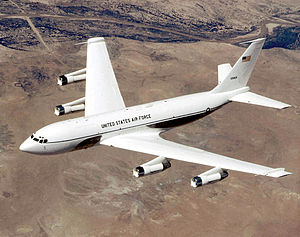C-135 Stratolifter
| C-135 Stratolifter | |
|---|---|
 |
|
| C-135C Speckled Trout | |
| Role | Transport aircraft |
| National origin | United States |
| Manufacturer | Boeing |
| First flight | 17 August 1956 |
| Introduction | June 1957 |
| Status | Active service |
| Primary user | United States Air Force |
| Produced | 1954–1965 |
| Number built | 803 |
| Unit cost | |
| Developed from | Boeing 367-80 |
| Variants |
Boeing KC-135 Stratotanker Boeing EC-135 Boeing NC-135 Boeing RC-135 OC-135B Open Skies WC-135 Constant Phoenix |
The Boeing C-135 Stratolifter is a transport aircraft derived from the prototype Boeing 367-80 jet airliner (also the basis for the 707) in the early 1950s. It has a narrower fuselage and is shorter than the 707. Boeing gave the aircraft the internal designation of Model 717. Since the first one was built in August 1956, the C-135 and its variants have been a fixture of the United States Air Force.
A large majority of the 820 units were developed as KC-135A Stratotankers for mid-air refueling. However, they have also performed numerous transport and special-duty functions. Forty-five base-model aircraft were built as C-135A or C-135B transports with the tanking equipment excluded. As is the case with the KC-135, the C-135 is also recognized as the Model 717 by Boeing.
Fifteen C-135As, powered by Pratt & Whitney J57 turbojets, were built. In later years, almost all were upgraded with Pratt & Whitney TF33 turbofan engines and wide-span tail planes, and were re-designated C-135E. Most were converted to various special roles, including airborne command posts, missile-tracking platforms, and VIP transports, and were withdrawn throughout the 1990s.
Thirty C-135Bs were built with the TF33 turbofans and wide-span tail planes from the start, and a small number remain in service in their original form. Ten were modified for a weather reconnaissance (flying through radioactive clouds from nuclear tests or other agents) role and designated WC-135B Stratolifter (Constant Phoenix in later versions). Additional airframes were converted to RC-135s from the 1970s to 2006, and remain in service with further equipment upgrades installed.
The C-135C designation applies to three WC-135B weather reconnaissance aircraft, which reverted to transport status. Most of the other C-135Bs were converted to various special mission variants following their service with the Military Airlift Command.
Although most of the remaining C-135 aircraft are used for transporting senior military leaders and other high-ranking dignitaries, the C-135C communications aircraft serves as an aerial test-bed for emerging technologies. Developmental tests using this aircraft have demonstrated the capability to fly precision approaches using a local area differential GPS system. This modified C-135 has been fitted with a millimeter wave camera and a radome to test the camera’s generation of video images of the forward scene in low-visibility conditions. The aircraft, which in the VIP/Distinguished Visitor (DV) transport role seats 14 passengers, also gives a Joint Forces Air Component Commander (JFACC) a limited ability to plan and control the simulated battle while in the air en route to the crisis area.
...
Wikipedia
